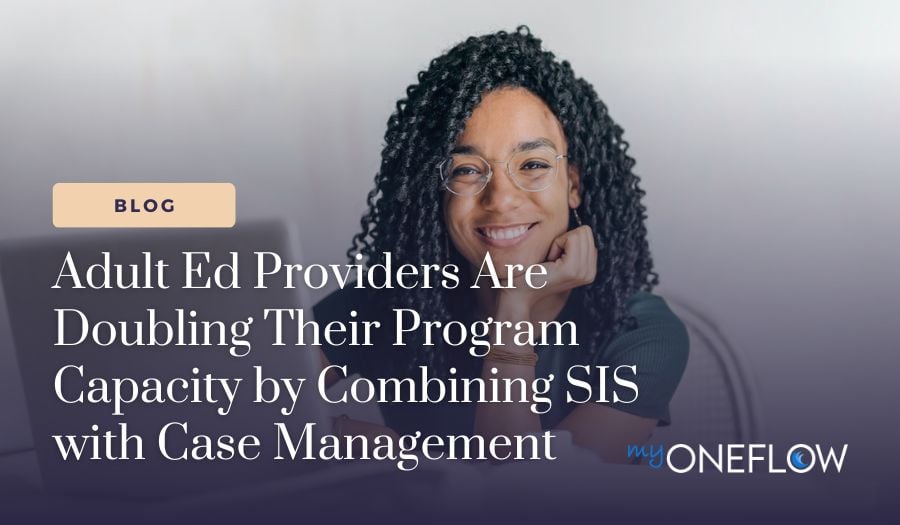Double Your Program Capacity by Combining SIS with Case Management
When we talk to adult education providers, we hear the same story time and time again. They use different systems – or worse, spreadsheets – to...
3 min read
myOneFlow Staff Mar 31, 2023 12:19:54 PM

Adult learners often face unique challenges, such as work and family responsibilities, that make it difficult to stay motivated and engaged in their studies. Retention is, therefore, a critical factor in the success of these programs. One effective way to increase retention rates is with nudges and reminders.
Nudges can provide positive reinforcement, celebrate milestones, offer feedback, and personalize communication. In this article, we’ll explore how nudges can be used to support adult learners in achieving their educational goals. We will discuss various strategies for implementing nudges in adult education programs and best practices for using them to improve retention and student success.
Nudges are small, gentle interventions designed to influence behavior without coercion or penalties. They work by tapping into our cognitive biases and nudging us toward making better decisions. In adult education, nudges can encourage adult learners to stay engaged in their studies, persist through difficult periods, and, ultimately, complete the program.
Personalization: Nudges can be personalized to individual learners, taking into account their specific needs and circumstances. By providing targeted support and feedback, nudges can help learners stay on track and achieve their educational goals.
Behavioral economics: Nudges draw on insights from behavioral economics, which suggests that small changes to the learning environment can significantly impact learner behavior. By making minor tweaks to the learning experience, nudges can encourage learners to take actions that are in their best interest.
Low-cost: Nudges are often low-cost interventions that can be easily implemented in adult education programs. For example, personalized text messages and emails can be sent automatically as a part of workflows, making it easy for educators to provide ongoing support to learners without requiring additional time or resources.
Timeliness: Nudges can be delivered at critical moments in the learning process, such as before a deadline or when a learner is struggling with a particular concept. By providing timely feedback and support, nudges can help learners overcome obstacles and stay motivated.
By using small, targeted interventions to encourage adult learners to stay engaged and on track with their studies, programs can support learners in achieving their educational goals and improve their chances of success.
Here are five ways nudges and reminders can provide positive reinforcement and support adult learners in their educational journey.
Nudges and reminders can be used to celebrate milestones. For example, when adult learners complete a module or pass a test, sending them a congratulatory message can boost their confidence and motivation to continue with the program. This positive reinforcement can be a powerful tool in helping adult learners persist through difficult periods and remain engaged in their studies.
Highlighting progress can be an effective way to use nudges and reminders. Regular updates on how much a student has completed or how far they have come can help them to recognize their achievements and build momentum. By seeing how their hard work is paying off, adult learners are more likely to stay motivated and committed to the program.
Nudges and reminders can be used to provide regular feedback to adult learners. This feedback can be used to point out what they are doing well or offer suggestions for improvement. Providing regular feedback helps adult learners stay on track and identify areas where they need to focus their efforts, ultimately leading to greater success in the program.
Personalizing messages can make adult learners feel more connected to the program. Addressing learners by name and referencing their personal goals can help them feel more valued and recognized. This can lead to a stronger sense of connection to the program, greater engagement, and improved retention rates.
Offering incentives can be an effective way to use nudges and reminders. Small incentives, such as a certificate of completion or a free course, can provide extra motivation for adult learners to complete the program. By offering incentives, programs can help adult learners see the tangible benefits of completing the program, which can be a powerful motivator.
Overall, nudging can be an effective tool for improving retention rates in adult education programs. Nudges can help learners stay on track and achieve their educational goals by providing personalized support at critical moments in the learning process. myOneFlow makes it easy to incorporate timely, regular nudges into the learner experience. Nudges can be built into any workflow, and myOneFlow’s AI-powered engine personalizes each nudge based on information collected throughout the student’s journey. Learn more about myOneFlow’s unique adult education software or contact our team to discuss your organization’s specific needs.

When we talk to adult education providers, we hear the same story time and time again. They use different systems – or worse, spreadsheets – to...

Adult learners make up almost 40% of the student population in higher education, and adult education is critical to the overall reskilling and...

Adult education programs face challenges that are grossly ignored and not being discussed in the public domain and hence fail to garner attention. In...